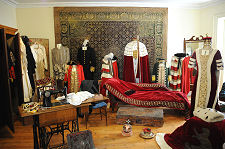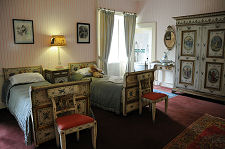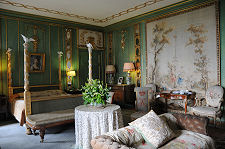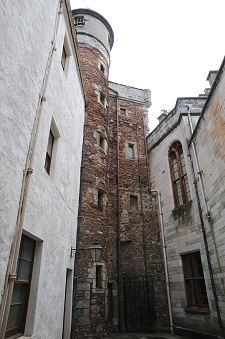 Dunrobin Castle Seen from the Gardens |
Dunrobin Castle stands on a prominent bluff set a little back from the shore a mile north-east of Golspie and four miles south-west of Brora. The castle itself is the nearest Scotland comes to fairytale architecture and laid out below it between the foot of the bluff and the sea are extensive formal gardens. Dunrobin Castle Gardens are the subject of a separate feature page, as is the superb Dunrobin Castle Museum, which stands just to the side of the gardens.
Visitors to Dunrobin Castle will find the entrance well signposted from the A9 not far from the edge of Golspie. The castle can be distantly glimpsed from the main road if you are approaching from the north-west, but for most visitors the first view will be of the castle's north face at the end of the tunnel of trees enveloping the main drive. This has a very imposing feel, but it pays to remember that this was not the side from which Dunrobin Castle was primarily intended to be viewed. Highlights, literally, are the five storey tower above the main entrance, and the clock tower.
A visit to Dunrobin Castle is highly recommended for anyone travelling up or down the A9 in eastern Sutherland. Visitors are able to take a self-guided tour through some 20 rooms in one of the finest and certainly the largest private residences anywhere in Scotland, emerging with some fascinating insights into the lives of those who lived here, both above and below stairs.
The tour begins in some of the grand public rooms of the castle, and includes the opulence of the wood panelled dining room and music room. The breakfast room seems almost too large for the purpose, though it is dwarfed by the drawing room and the superb library, home to over 10,000 books. The scale diminishes somewhat through the ladies' sitting room and the green and gold room. You are reminded that this was intended to be a large home for a large family in the day nursery, while the nearby night nursery and the nanny's room are more personal in size.
The seamstress's room contains a fine collection of the family's robes, while the Clan Sutherland room has information about the clan. The military room has a collection of arms and uniforms which reflects the family's many links with the army over the generations. The final "above stairs" room is our favourite. The duke's study is a beautifully proportioned and comfortably sized room panelled in Scottish larch. You then pass below stairs to visit the footman's pantry.
The tour ends in the excellent tea-room and the castle also has a gift shop. The castle itself is only part of the experience at Dunrobin and a visit to the gardens which stretch out below it is a must: for the gardens themselves, for the views they offer of the castle's prettiest face, and for the falconry displays which take place here. And at the north-east end of the gardens is the Dunrobin Castle Museum, a fascinating addition to any visit.
Many Scottish castles evolved over the centuries. The typical pattern was for a structure to be built with defence primarily in mind. In later centuries, when comfort and display became more important considerations, the original castle would be adapted or extended into a grand mansion, or simply replaced by a new building. Dunrobin followed the "extend and expand" route, but it did so in a way that must be unique. Here the castle had added to it a series of extensions which effectively grew out in a way that wrapped around the original keep, completely concealing it from exterior view. Today the structure of the keep can only be glimpsed from an internal courtyard.
The story of Dunrobin Castle is deeply entwined with the story of the Earls, and later the Dukes, of Sutherland. In about 1210 large parts of what is now Sutherland was granted by King Malcolm I to Hugh de Moravia, Lord Duffus, a knight of Flemish descent whose main family power base was at Duffus Castle in Moray. In about 1235 Hugh's son William, Lord of Duffus and Sutherland, was made 1st Earl of Sutherland by King Alexander II.
As holders of one of just seven medieval earldoms of Scotland the Sutherlands were part of the ruling elite of the country, intermarrying with many of the other leading families and with the Royal Family. In the 1300s the 4th Earl of Sutherland married a daughter of the Earl of Mar (and a granddaughter of Llewellyn Prince of Wales), while the 5th Earl married Princess Margaret, daughter of Robert the Bruce, and the 6th Earl married Margaret, daughter of Alexander, 1st Earl of Buchan. Alexander was the illegitimate son of King Robert II. He is better known to history as The Wolf of Badenoch because he routinely terrorised large parts of the Highlands and Moray. His most significant exploit was burning down the town of Elgin and its cathedral because of an argument with the Bishop of Moray.
Dunrobin Castle is first mentioned in writing as a stronghold of the family in 1401. The oldest parts still standing were probably built in the late 1300s and the name seems to come from Dun Robin, or "The Castle of Robin", after Robert, 6th Earl of Sutherland. The Wolf of Badenoch had died in 1394, and it is tempting to think that Dunrobin was built in the 1370 or 1380s as a means of ensuring that the 6th Earl would never receive a surprise visit from a man who must have been a rather daunting father in law! It is possible that the family had previously lived in an earlier structure on the same site, and the inclusion of the word "dun" in the name and the presence of Pictish stones and other remains in the area suggests that the site of Dunrobin Castle may have been been home to defensive structures for many centuries before the first part of the current castle was built.
In 1514 the Earldom of Sutherland passed by marriage to the Gordon family. In 1567 the 11th Earl and his Countess were murdered by an aunt hoping (unsuccessfully) to change the course of the succession. The 12th Earl married Jean Gordon, Countess of Bothwell, the divorced ex-wife of James Hepburn, 4th Earl of Bothwell, who became the husband of Mary Queen of Scots.
The 14th Earl of Sutherland saw the family through the troubled decades of the middle of the 1600s. He also, between 1641 and 1644, undertook the first major expansion of Dunrobin Castle. This involved the building of what amounted to a substantial mansion comprising two ranges wrapped around the north and west sides of a courtyard formed to the west of the original keep, which as a result became the east end of the new structure.
In 1766 the 18th Earl of Sutherland died, and was succeeded by his one-year-old daughter Elizabeth, who became 19th Countess of Sutherland. Elizabeth's right to her father's title was challenged in the courts, but decided in her favour by the House of Lords in 1771. In September 1785, Elizabeth Sutherland married George Leveson-Gower, Viscount Trentham, the son of the 1st Marquess of Stafford. When he inherited his father's title and became 2nd Marquess of Stafford in 1803 he also inherited enormously valuable estates including the Bridgewater Canal. After their marriage in 1785 the Sutherlands oversaw the remodelling of Dunrobin Castle. What was already there was upgraded, and a new south range was built, enclosing the central courtyard.
At the start of the 1800s the Sutherland estates of the Countess of Sutherland and the Marquess of Stafford amounted to some 1.5 million acres and formed the biggest private estate in Europe. Large numbers of people lived on the land. What followed was one of the most controversial episodes in the story of the Sutherlands when, between between 1811 and 1821, large numbers of people were cleared from the Sutherland estates, something that was also happening on other estates across the Highlands and Islands, in the cause of "agricultural improvement". We cover the story of the Highland Clearances elsewhere on Undiscovered Scotland, but there is no doubt that it is a subject which still has resonance today. In January 1833, six months before his death, George Leveson-Gower was made 1st Duke of Sutherland, effectively submerging the title of Marquess of Stafford beneath that of Duke of Sutherland. At the same time, Elizabeth became the Duchess of Sutherland.
After the death of her husband the Duchess of Sutherland extended Dunrobin Castle further, building a new north-west wing intended to provide the castle with adequate accommodation for the 2nd Duke and his family as well as for herself. The 2nd Duke of Sutherland inherited Dunrobin Castle on the Duchess's death in 1841. He had eight children, and this seems to have been one of the factors which led to his planning a vast extension to the castle. He commissioned the architect Sir Charles Barry to produce initial designs for a chateau which turned out to be too large for the site, and work began in 1845 on a final plan which was partly the work of Barry and partly produced by the 2nd Duke himself.
When work was completed in 1851, Dunrobin Castle was three times larger than it had been six years earlier. Everything already standing was extended in an easterly direction, producing new south and south-east fronts, an entirely new east end, and a new north front, which almost completely enveloped what was left of the original castle. The end result was described by Queen Victoria as "a mixture of an old Scotch castle and a French chateau." The total cost of the expansion was £54,663.
During World War I, Dunrobin Castle was used as an auxiliary naval hospital. A fire in 1915 badly damaged parts of the castle. It is said that much more would have been destroyed had it not been for the crew of a naval ship coming ashore to form bucket chains to tackle the fire. The Scottish architect Sir Robert Lorimer was engaged to oversee the repairs and he made major changes to the main tower and to many of the interiors in the years to 1921.
Dunrobin Castle as you see it today is the result of over seven centuries of development and redevelopment, all given a degree of unity by the huge expansion in the middle of the 1800s and heavily influenced by Sir Robert Lorimer's later work.
 The Dining Room |

|
|
|
Visitor InformationView Location on MapGolspie, KW10 6SF. Tel: 01408 633177. info@dunrobincastle.co.uk Grid Ref: NC 851 008 www.dunrobincastle.co.uk Opening Hours Admission Accessibility What3Words Location: ///search.moguls.majors |
Dunrobin Castle In Fiction
|
 The Duke's Study |
 The Main Staircase |
 The Library |
 The Breakfast Room |
 The Music Room |
 Ceiling Detail, Ladies' Sitting Room |
 One of the Four Doves |
 The Seamstress's Room |
 The Clan Sutherland Room |
 The Nursery |
 The Night Nursery |
 Footman's Pantry |
 The Main Tea-Room |
 Eyes Turned Skywards by Ken Lussey (12 August 2024).
Eyes Turned Skywards by Ken Lussey (12 August 2024).







